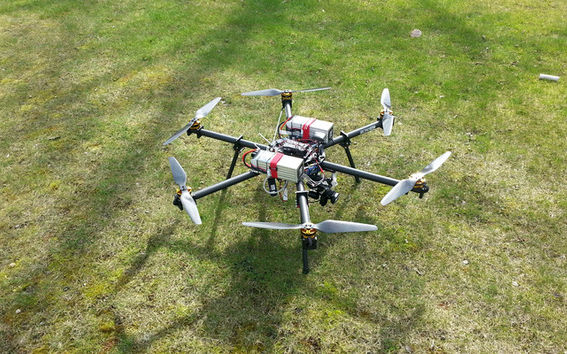Finland's first multicopter flight using 4G remote control conducted at Aalto University

The flight involved a six-rotor miniature copter using the Nokia LTE/4G test network in Otaniemi in Espoo. The successful development project and test flight show that LTE/4G technology can be extended in research work to guidance of a helicopter.
Guidance through the mobile network allows for a wide working radius as well as guidance from inside a building without visual contact, using only instruments and a video camera.
'The research indicates that 4G is fast enough for many purposes. 4G makes mobile technology available to hobbyists and opens numerous application possibilities for professional use. However, acrobatic flight by remote control would probably require 5G speed', says Research Assistant Lassi Sundqvist of the Department of Communications and Networking.
Traditionally, different kinds of model aircraft use 2.4 gigahertz radio guidance with the help of direct visual contact. Manoeuvrability is limited by a working radius of about one kilometre, which does not reach behind buildings, for instance.
Remote control through the mobile network makes it easier to follow a flight and to pinpoint the location of the helicopter in a possible problem situation.
'4G makes work easier and saves resources in rescue work, for instance, or in pinpointing problems with electricity lines, for instance.'
Opportunities and hazards
For now, legislation restricts the expansion of use into public networks.
'In addition to opportunities, there are also hazards in the use of the 4G network for remote control of the copters. It is therefore important to clarify and develop legislation', says Professor Heikki Hämmäinen of the Department of Communications and Networking.
Further research is also needed for the development of the quality characteristics of the mobile network. Matters to be studied include aspects such as the quality of the network service (QoS) and fluctuations that occur when the base station changes, for instance.
The study is part of research for the master's thesis of Lassi Sundqvist on mobile networks at the Department of Communications and Networking.
Video (YouTube)
Further information:
Professor Heikki Hämmäinen
[email protected]
Tel. +358 50 384 1696
Bachelor of Science (Technology) Lassi Sundqvist
[email protected]
Tel. +358 400 621 707
- Published:
- Updated:
Read more news

Get to know us: Associate Professor Maria Sammalkorpi
Sammalkorpi received her doctorate from Helsinki University of Technology 2004. After her defence, she has worked as a researcher at the Universities of Princeton, Yale and Aalto.
Aalto computer scientists in ICML 2024
Computer scientists in ICML 2024
In low-hierarchy organisations, even key policy issues are discussed in Slack
In a recent study, Aalto University alumn Lauri Pietinalho, a visiting scholar at New York University's Stern School of Business, and Frank Martela, an assistant professor at Aalto University, investigated how low-hierarchy organisations deal with shared policies in confrontational situations and how authority functions within them.